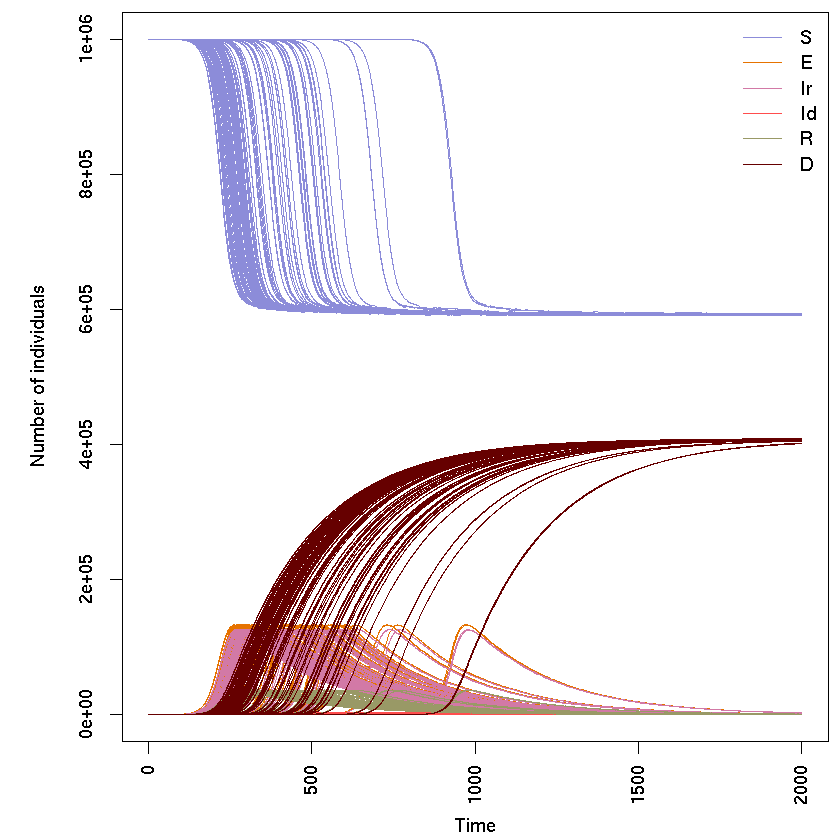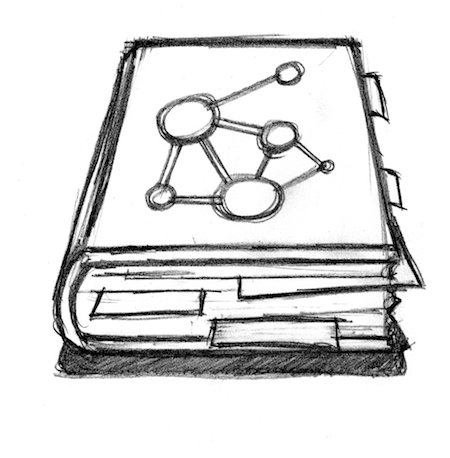Stochastic SEIRD model using odin
Author: Thibaut Jombart
Date: 2018-10-03
Requirements
This code uses odin, an R package for describing and solving differential equations. The commented commands will install the latest version of the package and its dependencies:
#if (!require("drat")) install.packages("drat")
#drat:::add("mrc-ide")
#install.packages("dde")
#install.packages("odin")
library(odin)
We also use the following helper functions:
## function to make colors transparent, stolen from adegenet::transp
transp <- function (col, alpha = 0.5) {
res <- apply(col2rgb(col), 2,
function(c) rgb(c[1]/255, c[2]/255,
c[3]/255, alpha))
return(res)
}
## x: instance of odin model
## t: time steps
## n: number of replicates
run_model <- function(x, t = 0:100, n = 1, ...) {
res <- x$run(t, replicate = n, ...)
res <- x$transform_variables(res)
res <- cbind.data.frame(t = res[[1]], res[-1])
attr(res, "n_compartments") <- length(x$names) - 1
attr(res, "n_replicates") <- n
attr(res, "compartments") <- x$names[-1]
class(res) <- c("pretty_odin", class(res))
res
}
## plot function
plot.pretty_odin <- function(x, pal = seird_pal, transparency=FALSE,...) {
## handle colors
n_compartments <- attr(x, "n_compartments")
n_replicates <- attr(x, "n_replicates")
col_leg <- pal(n_compartments)
alpha <- max(10 / n_replicates, 0.05)
if(transparency){
col <- rep(transp(col_leg, alpha), each = n_replicates)
}else{
col <- rep(col_leg, each = n_replicates)
}
## make plot
par(mar = c(4.1, 5.1, 0.5, 0.5), las = 3)
matplot(x[, 1], x[, -1], xlab = "Time", ylab = "Number of individuals",
type = "l", col = col, lty = 1, ...)
legend("topright", lwd = 1, col = col_leg, bty = "n",
legend = attr(x, "compartments"))
}
## colors
seird_col <- c("#8c8cd9", "#e67300", "#d279a6", "#ff4d4d", "#999966", "#660000")
seird_pal <- colorRampPalette(seird_col)
Model description
The model is specified in odin using:
seird_generator <- odin::odin({
## Core equations for transitions between compartments:
update(S) <- S - n_SE + n_RS
update(E) <- E + n_SE - n_EI + n_import_E
update(Ir) <- Ir + n_EIr - n_IrR
update(Id) <- Id + n_EId - n_IdD
update(R) <- R + n_IrR - n_RS
update(D) <- D + n_IdD
## Individual probabilities of transition:
p_SE <- 1 - exp(-beta * I / N)
p_EI <- 1 - exp(-delta)
p_IrR <- 1 - exp(-gamma_R) # Ir to R
p_IdD <- 1 - exp(-gamma_D) # Id to d
p_RS <- 1 - exp(-omega) # R to S
## Draws from binomial distributions for numbers changing between
## compartments:
n_SE <- rbinom(S, p_SE)
n_EI <- rbinom(E, p_EI)
n_EIrId[] <- rmultinom(n_EI, p)
p[1] <- 1 - mu
p[2] <- mu
dim(p) <- 2
dim(n_EIrId) <- 2
n_EIr <- n_EIrId[1]
n_EId <- n_EIrId[2]
n_IrR <- rbinom(Ir, p_IrR)
n_IdD <- rbinom(Id, p_IdD)
n_RS <- rbinom(R, p_RS)
n_import_E <- rpois(epsilon)
## Total population size, and number of infecteds
I <- Ir + Id
N <- S + E + I + R + D
## Initial states
initial(S) <- S_ini
initial(E) <- E_ini
initial(Id) <- 0
initial(Ir) <- 0
initial(R) <- 0
initial(D) <- 0
## User defined parameters - default in parentheses:
S_ini <- user(1000) # susceptibles
E_ini <- user(1) # infected
beta <- user(0.3) # infection rate
delta <- user(0.2) # inverse incubation period
gamma_R <- user(0.2) # recovery rate
gamma_D <- user(0.4) # death rate
mu <- user(0.05) # CFR
omega <- user(0.1) # rate of waning immunity
epsilon <- user(0.05) # import case rate
}, verbose = FALSE)
Running the model
The model is first parsed and compiled using odin::odin, and user-provided parameters are passed using the resulting model generator (the object seird_generator). All parameters specified in the model description above as user() can be set through the model generator. Here, we use 1 initial exposed individual, 1 million susceptibles, and run 100 independent simulations:
set.seed(1)
seird <- seird_generator(S_ini = 1e6, E_ini = 1, epsilon = 0.01, omega = 1)
x <- run_model(seird, t = 0:2000, n = 100)
plot(x)

